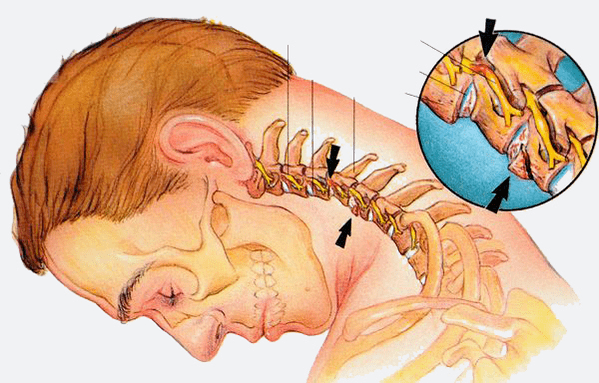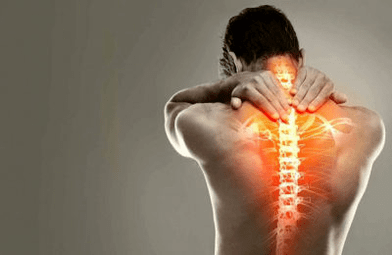Many people deal with today's lack of physical activity.Monotonous work in the office, long stay at home, as well as inadequate foods - these are the main causes of many diseases.One can be called osteochondrosis of the cervical region, one of the most mobilized segments of the human spine.It has a huge amount of load daily because its main function is to hold the head.
This disease causes significant discomfort in patients' lives and is just as common in both women and men.The disease is considered to be progressive, which involves degenerative-dynist disorders of intervertebral discs and therefore requires treatment for qualified medical care in time.
Causes of the development of pathology

Osteochondrosis can affect all classes, but given the increased activity of the cervix region, it develops very often.
The disease is conditionally divided into 4 main sections:
- The first is associated with the initial disorders of the spinal objects accompanied by unstable properties and the symptoms are low pronounced.
- The second - in which the gaps between the vertebrae decrease and the destruction of the fiber ring, the violation of the nerve roots, and as a result the pain is possible.
- The third - when the ring is destroyed in the final stage, the intervertebral hernia can occur and often there are signs of deformation of the spine.
- The fourth is the most severe stage when bone growth occurs and all movement becomes very painful and almost impossible, which in the absence of treatment can cause disability.
Currently, osteochondrosis is significantly detected in young people, including cervical regions.If this disease was previously considered age-related and found in patients 40, young people aged 18-30 are often often confronted with this problem.
The causes of the disease are as follows:

- overweight problems;
- posture violation and curvature of the spine;
- delayed metabolism processes in the body;
- Various trauma of the spine;
- Serious physical work and systematic raising of significant weights;
- Some sports classes, violation of the training process;
- Weak general physical training, especially the weakness of the back;
- systematic hypothermia;
- conveyed infectious diseases;
- Sitting lifestyle, lack of physical effort.
The causes of restriction of mobility in the cervical region are also typical.These are muscle spasms, blood supply deterioration, tightening nerve endings, narrowing of holes between vertebrae, and developing diaphrages and intervertebral discs.
The symptoms of the disease
Symptoms and typical signs of cervix osteochondrosis are primarily results in violations of the head and brain blood supply.This is due to the fact that the cervical region is saturated with the blood vessels and is due to the human brain nourished.
The characteristic symptoms of the pathology of the cervical class are as follows:
- headache, which can be severely and systematic depending on the degree of disease;
- Dizziness of the cervix osteochondrosis is often accompanied by loss of consciousness;
- the presence of a distinctive ring in the ear, often a decrease in hearing;
- violation of coordination of movements, walking;
- vision vision;
- the increased temperature of the skin and sometimes the total increased body temperature;
- Sound changes, such as the hoarseness of the sound or the presence of hoarseness;
- the unsatisfactory condition of the teeth;
- feeling of numbness of fingers, feeling of cooling and weakness of hands;
- Pain in the neck, throat, pain with the skin of the head, sometimes even toothache;
- hand -to -hand pain in the shoulders and its reinforcement with various turns or movement of the neck and head;
- Nausea or even vomiting that can accompany severe pain.
Headaches, mobility restrictions and other symptoms in the complex and separate, and intensity can be different.As a general rule, it directly depends on which object the disease affects.Based on this, the disease is classified as SO radicular syndrome, spinal artery syndrome, spinal cord syndrome, reflex syndrome and others.
Treatment of osteochondrosis of the cervical spine
If there is a lack of treatment for osteochondrosis of the cervix, patients may experience typical symptoms of untreated disease (headache, memory deterioration, temperature, dizziness, etc.) and then have quite unpleasant consequences.For example, it can be a violation of cerebral circulation, which is a result of deterioration of blood flow through blood vessels.

To avoid this, a patient who noticed the first signs of pathology should be asked for qualified help.
The patient can also use analgesics and anti -inflammatory drugs (tablets, ointments, injections) to provide first aid.You can also use ointments with warming drugs with ointments, or bee poisoning, or as a basis before visiting a doctor before visiting a doctor.Diuretics should be used when edema develops or swelling with folk drugs such as herbs.As far as the doctor's visit is concerned, this should be mandatory, regardless of the patient's relief during medication on its own.
Do not heal the protracted cervix -osochondrosis.
The cervical spine osteochondrosis is usually diagnosed with complaints from the patient.To confirm the diagnosis, methods such as radiological examination, CT or MRI are used.
After the diagnosis has been confirmed, the specialist prescribes treatment depending on the stage of the disease, depending on the individual characteristics of the whole patient as a whole.It is worth noting that you can only get rid of the problem in the initial stages.Treatment with folk remedies can be quite effective in treating the pathology at the beginning of the pathology.
As for the more advanced section of the cervix osteochondrosis, their treatment is reduced to reduce the discomfort, pain and physical suffering of patients.A competent and integrated approach can eliminate the main symptoms of the disease and prevent possible aggravation and suspend the development of the spine.
A comprehensive treatment of the disease includes the use of conventional medicine and non -to -traditional methods.In addition, further treatment with folk cures is allowed during the remission phase.
Among the most common methods of treating the disease are:

- vacuum therapy;
- Medication;
- acupuncture;
- laser therapy;
- electrical stimulation;
- dry grip;
- Treatment of magnets;
- Classes of therapeutic gymnastics;
- Therapeutic massage, etc.
To remove the pain syndrome, it is usually enough for the patient to hand over 1-3 treatment sessions.For the consolidation of positive therapeutic success, approx.10-15 therapeutic sessions may be required.After removing the acute stage, therapeutic gymnastics and massage are used.This helps to restore blood circulation and strengthen muscles.























